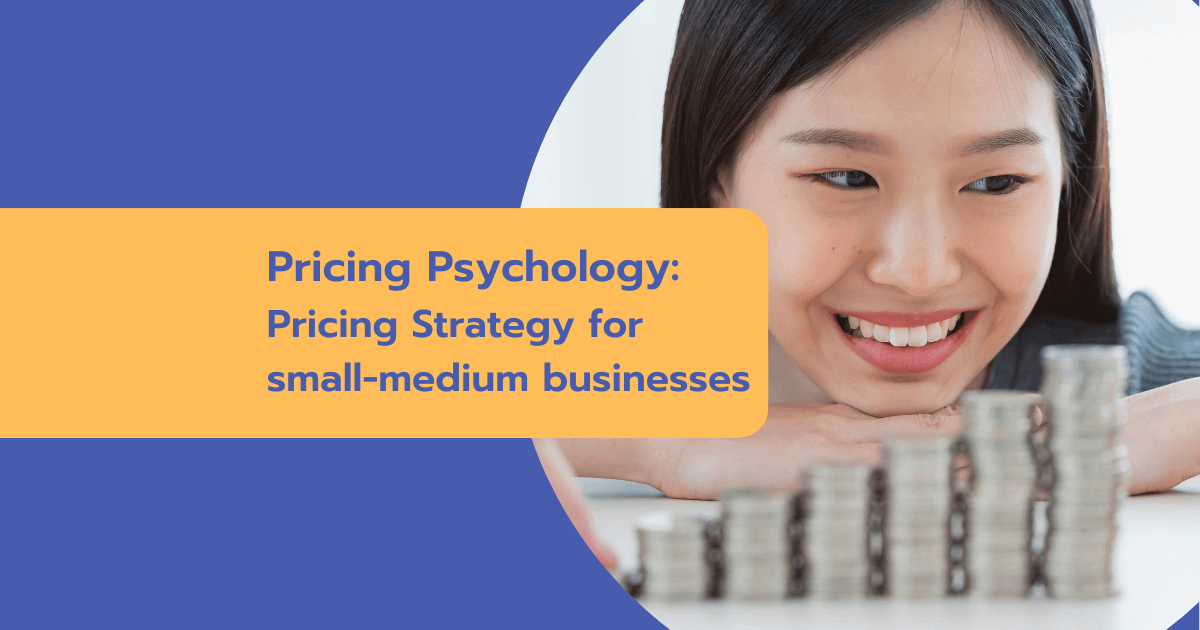“This the season to be jolly!” Ok, it might be a little early to sound Christmas bells, but whether you celebrate or not, it’s never too early to start planning as a small-medium business. With festive seasons coming up, there is plenty of opportunity to tap to optimize Pricing Strategy for small-medium businesses Is tapping on such sales the best solution for your business, or does it hurt your brand? In this four-part series, we explore pricing psychology and the impact of sales for small businesses.
Pricing Strategy for small-medium businesses
What is a pricing strategy?
When it comes to pricing for small and medium businesses, there are a few things to keep in mind. First, a pricing strategy is how a company sets prices for its products and services. A business may use various methods, depending on what type of business it is and what market they operate in.
There are many different pricing strategies that businesses can use, including:
- Cost-Plus Pricing: This strategy involves setting a price based on the cost of manufacturing a product and adding a margin.
- Competition-Based Pricing: This strategy involves comparing your prices with those of competitors to determine where you should set yours.
- Penetration Pricing: This strategy involves lowering prices to attract new customers and increase sales volume. The opposite of this is a high-low pricing strategy in action. This pricing strategy is mostly used by retailers with seasonal products, such as fashion and outdoor stores.
- Psychological Pricing: This strategy involves using psychological principles such as rounding prices up or down to make them seem more appealing to consumers (i.e., “rounding up” ฿20.99 to ฿21).
Psychological pricing taps on the fact that consumers rarely know the raw cost of a product. Instead, they determine if something is a good deal only if they get it for a better price than customarily listed or by comparing it to similar products in the same category. There are plenty of psychological techniques businesses can use, but let’s understand some through examples in the section below.
Examples of businesses that use psychological pricing to optimize sales and how it works
Here are a few key examples of how businesses use pricing to optimize year-end sales and how it works.
1. Charm pricing and odd-even pricing
You’ve probably seen value dollar chain stores around and browsed through them to buy various household items or snacks. Value dollar chain stores typically have huge red placards proclaiming their prices, with the price ending in a ฿0.99 number. These shops are the simplest example of charm pricing, the easiest psychological pricing method, which removes one cent from the rounded dollar price of an item. So that way, your brain is tricked into thinking something costs less. So ฿400 becomes ฿399, and the customer sees and remembers the 3, not the 4. A similar practice is odd-even pricing. Studies have shown that customers purchase items that end in an odd number (a phenomenon known as ‘left digit’ bias), more so than they did for prices with even numbers. Another study also showed that even when the odd-priced item increased in price later, a poorer memory for odd prices were noticed, along with a false belief that these items were not more expensive.
2. Expensive means good
This is a psychological pricing tactic that plays on these principles. The first is that a product priced high seems more valuable and, therefore, can attract more buyers. In comparison, a product priced too low can turn off customers, who will perceive it as less valuable. This strategy of premium pricing is easily understood through Apple’s pricing strategies. You might have noticed that Apple products have become increasingly more expensive. From an average of ฿28,000 for a smartphone (iPhone 6) in 2016, the price of the new iPhone 14 Pro is now almost ฿45,000 in Thailand. Yet, even with news of inflation, shoppers still flock to queue for the new iPhone. Google the trend, and this repeats yearly.
Why is Apple so successful in creating this frenzy for its smartphones? Part of it is due to its marketing strategies and core product features. But a significant factor is also due to its premium pricing strategy. Consumers equate price with quality, even when the same smartphone demonstrates similar features. A US-based study shows that consumers who paid more for their Italian buffet felt they enjoyed it more. When tested with another group, who paid less for the same buffet, the diners rated their satisfaction lower than those who spent more. Consumers perceive value through how much they pay, thinking they will enjoy more if the price is high. If you’ve noticed the prices of Apple products, you will also realise that the company utilises ‘odd-even pricing’. An iPhone 14 costs ฿45,000, and a Macbook Air costs ฿43,000. The prices always end in an odd number and never in an even number. 
3. The way your price appears impacts your consumers’ spending
How a price appears and the product can influence your customers’ feelings about it. A business study found that prices of different products are evaluated differently. For example, consumers buy recreational or luxurious products if they have price tags with rounded numbers. For instance, you might notice that the wine section often has a zero behind rather than a number. However, for products that consumers use every day, the customers tend to purchase more expensive products. That means a ฿199 calculator will sell better than a ฿100 calculator. An article by the Atlantic cites that this was due to a pricing effect. Round numbers trigger customers’ feelings, whereas irregular prices give customers a reason to pause and compute whether it’s a reasonable price. Notably, New York Times reports that even zeros can make customers feel they are paying more. A Cornell University study supports this and even shows diners spend more when restaurants remove the dollar sign from their menus. All these show that crafting a signboard of prices matters when you consider how your customers register your prices and how attractive your product looks compared to the price. So whether you’re a cafe, restaurant, food kiosk, or even a retail business, you need to consider how you display your products. If you’re looking for an example of such menu strategies, consider Starbucks. Starbucks is a grandmaster in this area with its carefully crafted beverage menu. Everything, including removing the currency sign (฿ or $) from its menus, and its ever-changing ‘novelty’ recipes, is psychological pricing techniques designed to make consumers spend more.
Final tips for small-medium businesses and psychological pricing
Let’s try a mix of the above pricing techniques. Perhaps keep these quick tips in mind when planning your strategy:
First, you want to ensure that your price is competitive with the market.
- Second, you want to ensure that your customers understand how much value they’re getting for what they pay. They’ll be more likely to buy from you if they think they’re getting value for their money.
Thirdly, consider offering promotions and loyalty rewards instead of remixing your price strategy. Finally, encourage referrals for word-of-mouth advertising. In the long run, this will increase your customer base and place your product or services firmly in the mind of your customers without significantly affecting your prices.
Qashier Smart POS Solutions
With the above information, it should allow you to give your customers a convenient, quick and personalised way of experiencing tasty food without sacrificing their time. In turn, they will keep coming back for more. Qashier offers multiple digital solutions, including QR code table ordering, table management (F&B), employee management, customer relationship management (loyalty programs), inventory management, data analytics, and cashless payments, in an all-in-one device. Qashier promises a seamless setup within 10 minutes, without any need for technical expertise. It boasts a user-friendly interface that is simple for anyone to learn and use. You’ll find 7-days-a-week responsive technical support from the local team if you require assistance Speak to us to see if Qashier’s Smart POS can meet your business needs. Schedule a meeting with us at 02-506-1934 or Contact us via Line Official: @qashier.th


